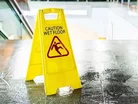Is Your Hospital a Danger Zone?

According to a report released by the United States Bureau of Labor Statistics in 2009, lost-workday injuries resulting from same-level slips, trips and falls occurred to 38.2 per 10,000 hospital workers, which was about 90 percent higher than the average incidence rate for all other private sectors.
In hospitals, slips, trips and falls are the second most common cause of injuries that lead to loss of workdays.
As such, it is essential for hospitals to take effective measures to reduce the risk of slips, trips and falls among their employees and patients.
Common Hazards Contributing to Slips and Falls in Hospitals
Slips and falls can happen because of many reasons, ranging from carelessness to improper maintenance.
The National Institute for Occupational Safety and Health identified the following hazards as the main causes of slips, trips and falls in healthcare settings.
- water and contaminants on the floor
- clutter and other tripping hazards
- stairs and handrails
- ladders and stepstools
- negligent use of floor mats
- irregularities in walking surfaces
- clogged drains
- inadequate lighting
- weather conditions
How to Prevent Workplace Falls
Depending on their severity, slips and falls can cause no physical harm at all or result in minor or serious injuries, permanent disabilities or even death.
According to an article entitled "Preventing Slips and Falls in Healthcare Settings", about 45 percent of slips, trips and falls inflict injuries to the knees, ankles, legs and other lower extremities, and almost half of them are sprains, strains, tears and dislocations.
Slip, trip and fall injuries may cause hospital employees to experience reduced productivity and work quality, and hospitals may be liable to pay compensation claims if they are found guilty of negligence.
Below are some measures that hospitals can take to minimize the risk of slips, trips and falls:
- Create a written housekeeping program to ensure that housekeeping tasks are always performed with safety in mind.
- Educate employees about the possible consequences of slips, trips and falls, and provide clear instructions on how to recognize, prevent, remove and report slip, trip and fall hazards.
- Add more spill stations to give employees easy access to cleaning materials.
- Make sure that employees mix cleaning products according to manufacturers' recommendations.
- Install slip-resistant flooring.
- Use water-absorbent and beveled-edge mats at entrances.
- Place "wet floor" caution signs on wet and slippery surfaces, or cordon off slippery areas.
- Encourage employees to wear slip-resistant shoes.
- Keep walkways, hallways and work areas clear of clutter and other tripping hazards.
- Use protective covers or tape to cover cords on the floor.
- Replace damaged floor tiles, carpet and mats.
- Patch walkway cracks that are wider than one quarter inch.
- Install more lighting fixtures in areas that are poorly lit.
- Make sure that handrails are 34 to 38 inches high.
- Paint the edge of every step of a staircase to enable users to see the change in elevation.
- Warn employees of freezing and icy weather conditions.
Slips, trips and falls do not only cause harm to the people involved; they can also have drastic consequences on hospitals.
While it is impossible to completely prevent slips, trips and falls, hospitals can significantly reduce the rate of these accidents by following the tips mentioned above.
About the author: John McMalcolm is a freelance writer who writes on a wide range of subjects, from social media marketing to health care.



